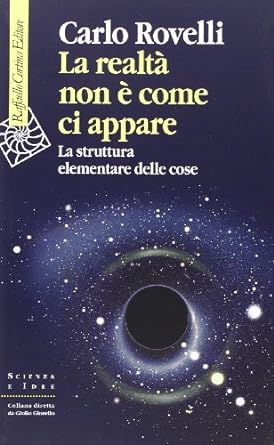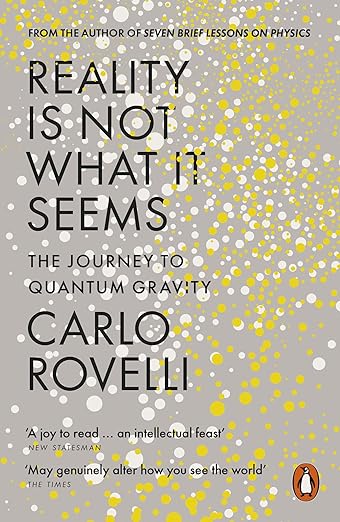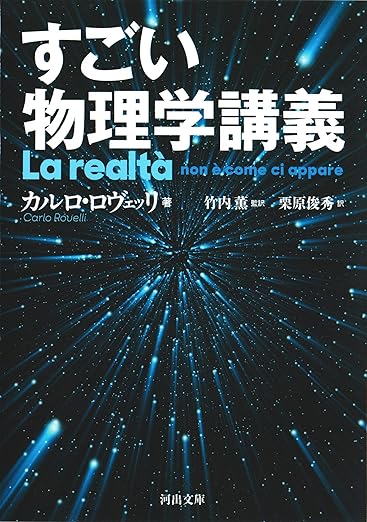


すごい物理学講義 (Time doesn’t exist)
by Carlo Rovelli
書評「めぐりあう書物たち」 (Book review ”Book come across”)
by 尾関章 (Akira Ozeki)
If you continue reporting on science for a long time, you can kind of see the changes in scientists’ interests. One of the reasons is that in recent decades, more emphasis has been placed on things than things.
The reason behind this is that the elemental reductionism that colored 20th century science has reached its climax. In physics, this is the case with the rush to discover elementary particles. In the life sciences, genome decoding corresponds to this. We are approaching the limit of our ability to explore the origins of matter and life.
What emerged in its place was the science of complex systems. I’m not really interested in dividing things into smaller parts. What interests me is the relationship between things. It can also be called a network. Network theory is discussed across disciplines, from physics to biology, and from basic science to applied technology.
The trend of emphasizing networks may be related to the fact that humans themselves have become components of networks. With the spread of computers and the advancement of information technology (IT) in the latter half of the 20th century, everyone became able to connect with people around the world through the Internet. Nowadays, human society cannot exist without networks. Our thinking is connected to networks on a daily basis. Naturally, science will change as a result.
The reason why I mentioned this topic to Pillow is because I associate networks with the theory of quantum gravity in “Amazing Physics Lectures” (authored by Carlo Rovelli, supervised translation by Kaoru Takeuchi, translated by Toshihide Kurihara, published by Kawade Bunko, 2019), which I have been discussing since last week. This is because there are stories that will make you do it. Since the author considers infinitesimal space, at first glance it may seem like elemental reductionism. However, as I read further, it seems that this is not the case. Although we are assuming elements, we are looking at something network-like.
Now, let’s return to the contents of this book. Last week, this book led me to the entrance to the theory of quantum gravity, which aims to integrate quantum mechanics and general theory of relativity. It can be summarized in two points. The first point is that space is not infinitely divisible, but has a “granular” quality in extremely small areas. Another is that there is a basic equation called the Wheeler-de-Witt equation in this area, and this equation allows us to imagine space as a “cloud made up of different geometric figures overlapping each other.”
However, even if you say that, it doesn’t make sense. The fact that space is “particles” and the fact that it is “cloud-like” are not connected. I want to read this book further this week and get rid of this feeling of confusion.
Let’s start by asking whether the Wheeler-de Witt equation can be solved. According to the book, the equations were improved around the end of the 1980s, and a “strange solution” was discovered. The solution was obtained when “closed lines” (rings, loops) in space were “objected to calculation.” Another way of saying this is that a “closed line” “appears in the solution.” Apparently, loops have a special meaning. This is where the name “loop quantum gravity theory” comes from.
This doesn’t get the point across, so let’s get some help from visual materials. The book contains images of ring-like loops intertwining in all directions. If you read the text, you will see that the solution to the Wheeler-de Witt equation seems to represent the state of each loop.
The author also calls the loop the “Faraday field line of the gravitational field.” Michael Faraday (1791-1867) expressed the force of electric and magnetic fields using Faraday field lines, but this is a gravitational version of Faraday’s field lines. Since we are visualizing the state of the gravitational field, it must also be related to the curvature of space.
The points where loops touch each other are “nodes.” According to the book, these are “quantum grains of space,” or “quanta of space.” What must not be overlooked is the statement that the “volume of space” is “inside the nodes.” According to our common sense, “volume” is a continuous quantity that spreads out in space, but in quantum gravity theory it is different. “Nodes” have the character of “discrete small boxes that form a volume.” As a result, the “volume” takes on the value of Tobitobiki, and is counted as one or two.
This book also emphasizes that the “quanta of space” called “nodes” “have no place.” Since the “knots” themselves “shape the space,” they cannot locate their “place” within the space. This is very different from photons (particles of light), which are quanta of electromagnetic fields.
So, is there an alternative to the “quantum of space”? According to this book, yes. That is information about what is next to each other. Next to one “quantum of space” there is another “quantum of space”. The landscape of a space changes depending on who is next to whom.
This is the highlight of this book. “Who is next to whom?” means focusing on relationships. An image of a network comes to mind. The author’s theory of quantum gravity traces space down to the smallest particles and seems to see a web within it.
According to the author, the structure of space is made up of “nodes” that “touch each other”. At this time, a line called a “link” is assumed to connect the “nodes”. “Only through links, only in the relationships between one link and another, can individual spatial quanta be located.” The relationship between “links” also affects the “quantum of space.” I would like to note here that the author himself uses the word relationship.
By the way, from the perspective of the Wheeler-de Witt equation, a “link” can be said to be part of a loop. It can be thought of as a manifestation of the gravitational field. The gravitational field also follows quantum theory, so just as electromagnetic fields appear in the form of quanta called photons (particles of light), “links” also have quantum aspects. According to this book, this quantum is quantified by the width of the boundary surface when two nodes touch each other. Therefore, “area” also takes a value of Tobitobiki, similar to quantum theory.
The author points out that the “volume” of “nodes” and the “area” of “links” “characterize the quantum network of space.” As I read this book, I kind of realized that when we talk about what the space of the microscopic world is like, we should not imagine this space that we are currently in. There is no common sense space there. There are only “nodes”, which are particles of space, and “links” that connect them. Together with quantities such as “volume” and “area,” they form a gravitational field.
This book also includes schematic diagrams of “sections” and “links.” At first glance, they look like the vertices and edges of a polyhedron. It also resembles a diagram simulating a network such as a communication network. From this diagram, we are convinced that the latest physics, known as loop quantum gravity theory, sees networks at the root of the world.
Anyway, what exactly is a loop? This book also has some hints. The author argues that by walking the links from node to node and back, you can measure the curvature of space in one turn. This is similar to how humans measure the curvature of the Earth. For example, if you travel in a loop from the North Pole, go south, move east-west around the equator, go north, and go to the North Pole, you can detect how the Earth’s surface is curved. The loop seems to be related to spatial distortion.
Let’s summarize the story so far. In loop quantum gravity theory, the microscopic world has a granular nature. The grains of space are called “nodes.” A “node” is itself a space, so it is not in space. The location of a “section” is determined by information such as “who is next to whom.” A network of nodes and links connecting them forms the structure of the space. If you follow the “link” once, it becomes a loop, and from there you can see the curve of the space.
I see, the structure of space is like that. However, the topic of time does not come up easily. The author says that we don’t need time, but he doesn’t seem to be completely denying the flow of time. What happens to time in a microscopic world where space becomes particles? I will continue reading this book next time.
From 38 to Mr.Ozeki
Dear Mr. Ozeki,
I will write what I feel, fully aware of the things I don’t know and don’t understand.
I have heard that it is the job of people in experimental physics and applied physics to deny what comes out of theoretical physics and applied mathematics. It’s said to be a pleasurable feeling.
The Wheeler-Dwitt equation, which came out of theoretical physics and applied mathematics, has not been checked by experimental physics or applied physics. It is too early to accept something that has various problems, such as not including time as a variable or resulting in countless meaningless solutions, just because it serves as a guideline for constructing a theory of quantum gravity. I feel like that.
The problem is that people in experimental physics and applied physics are not interested, so no one wants to check. Or rather, it’s probably an equation that no one can confirm.
A person who accepts the Wheeler-DeWitt equation unconditionally may say, “Time is just a concept created by anthropocentric subjectivity,” or “The flow of time is not a physical phenomenon.” Even if you justify an equation that doesn’t include time by saying, “Time doesn’t exist,” it will eventually be shown to be wrong by experimental and applied physics. I’m dreaming of such a day.
Physics is said to progress as far-fetched ideas are refuted one by one, so the Wheeler-DeWitt equation and the loop quantum gravity theory probably contribute to the progress of physics. To such outsiders, Carlo Rovelli’s books seem to be “interesting and entertaining stories” that are completely different from the facts.
If theoretical physics is natural philosophy, then I think Carlo Rovelli is truly a theoretical physicist. However, if we think of theoretical physics as purely rational and logical, the story becomes different.
I don’t think it’s a coincidence that Carlo Rovelli, who moved to France in 2000, was able to advance freer and more original discussions in France’s tolerant society. To do. Loop quantum gravity theory can only be born in an environment where society respects opinions different from those of others, and universities where interdisciplinary work is the norm.
Carlo Rovelli, who was arrested in Italy for refusing to be conscripted into the military and criticized in the United States for being unprofessional, saw him active in France and was a perfect match for everyone. I really felt that there was a place for me to be.
The above is just my personal opinion.
From Mr.Ozeki to 38
Dear Mr. 38,
“The problem is that people in experimental physics and applied physics aren’t interested, so no one wants to check. Or rather, it’s probably an equation that no one can confirm.》
I also think that the Wheeler-de Witt equation is an equation that no one can confirm.
Rovelli himself probably thinks so too.
I guess his main concerns are the following two.
1) Reconcile quantum mechanics and general relativity.
2) Thoroughly apply Democritic atomic theory to the ultimate microscopic space-time.
From this point forward, it will be considered the wild argument of an outsider, but regarding 2), his theory is consistent with the real world in that it can resolve Zeno’s paradox of “Achilles and the Tortoise.”
It may be fair to say that it has been verified to a certain extent.
めぐりあう書物たち/尾関章
「読む」「考える」の by chance
2023年10月27日 投稿者: AKIRA OZEKI
ロヴェッリの物理、空間は網
https://ozekibook.com/2023/10/27/ロヴェッリの物理、空間は網/